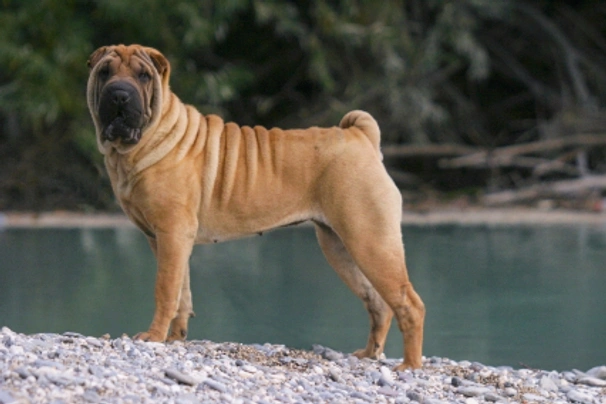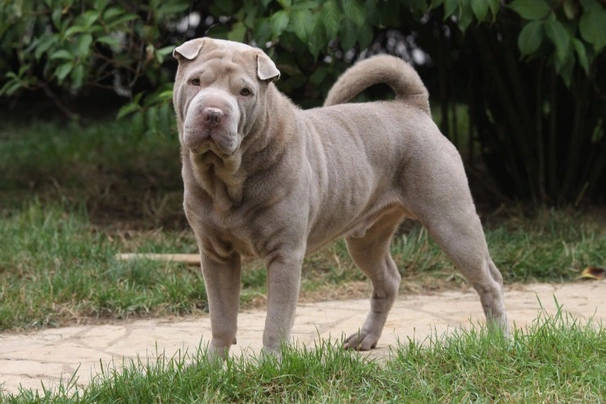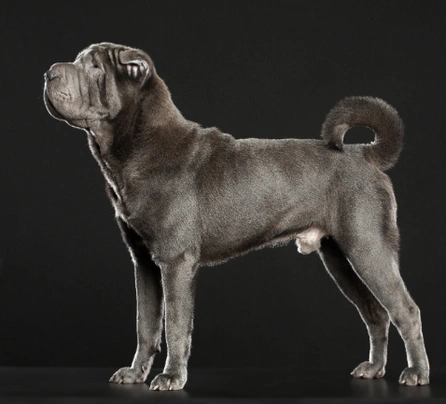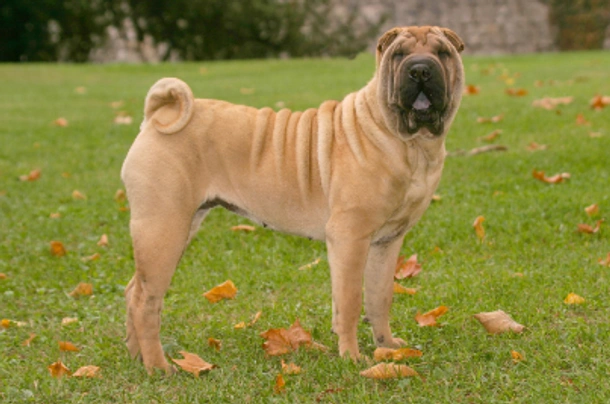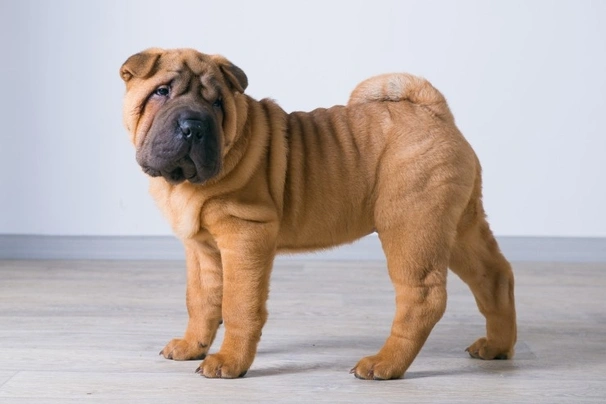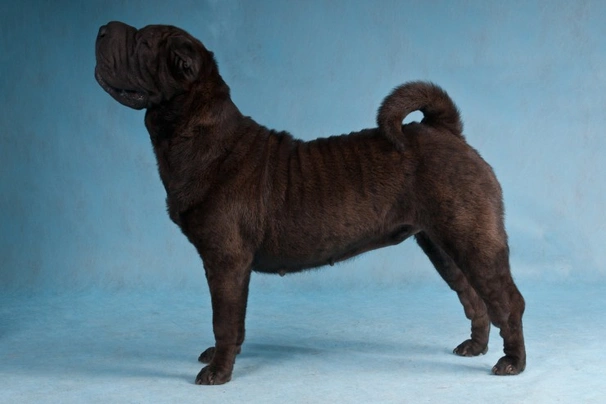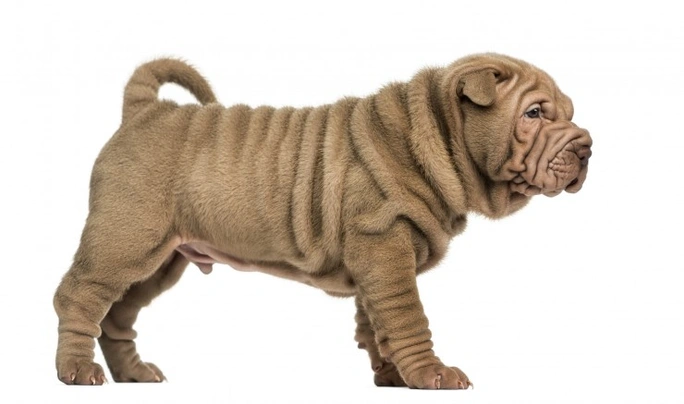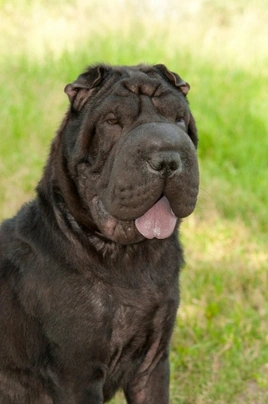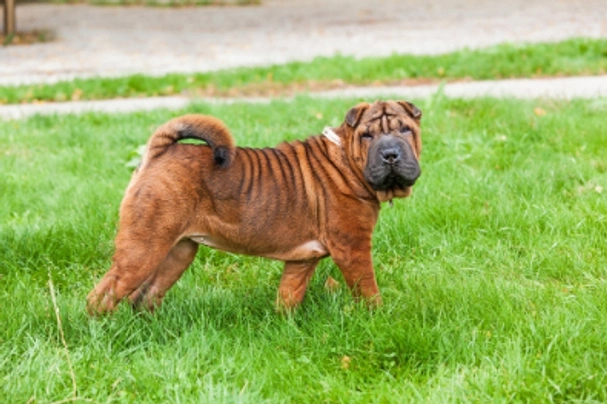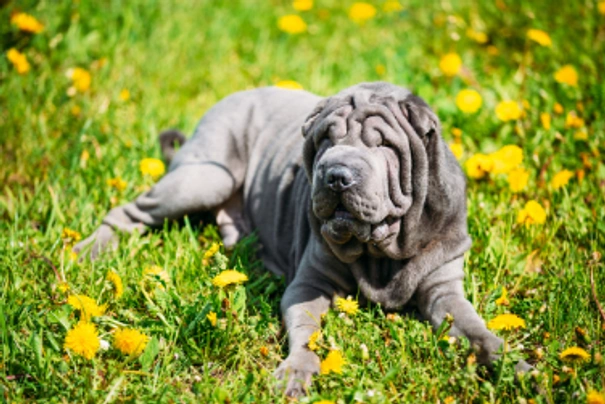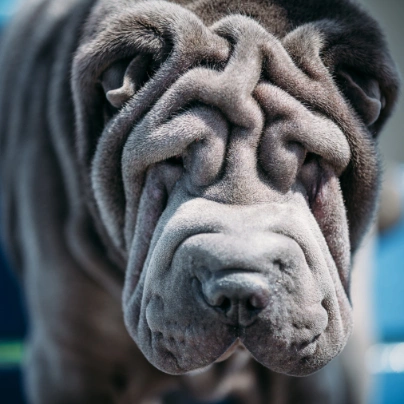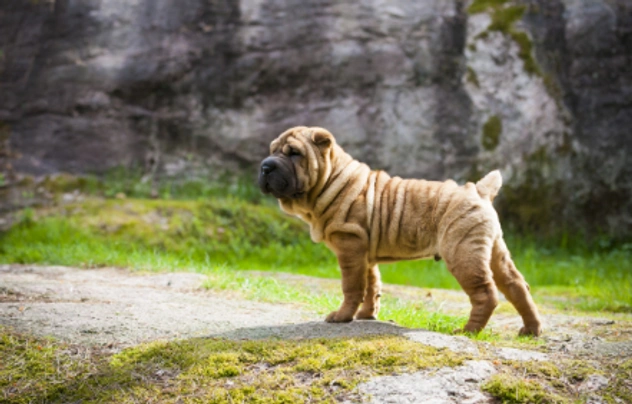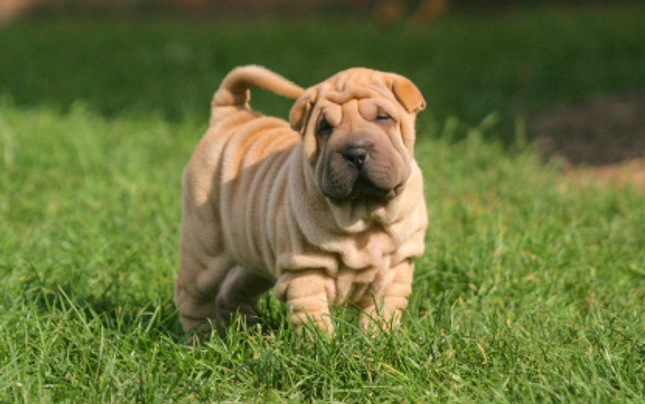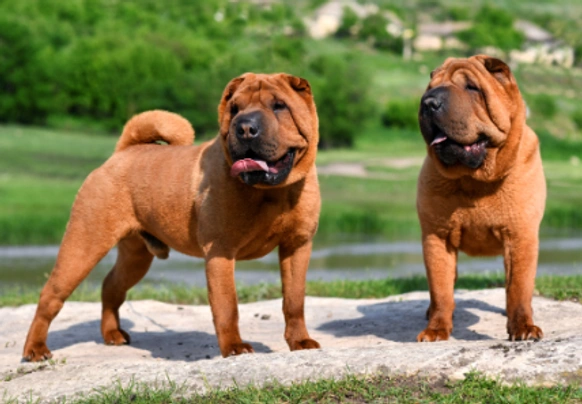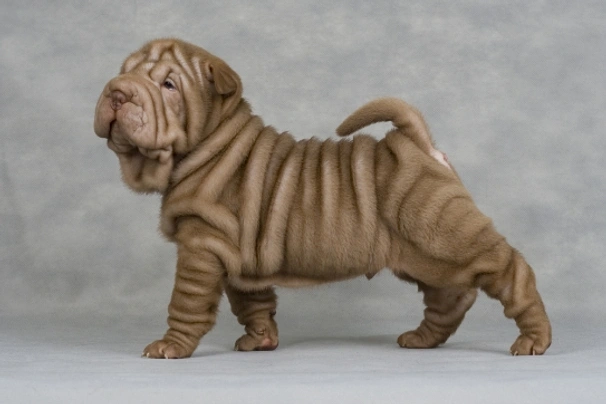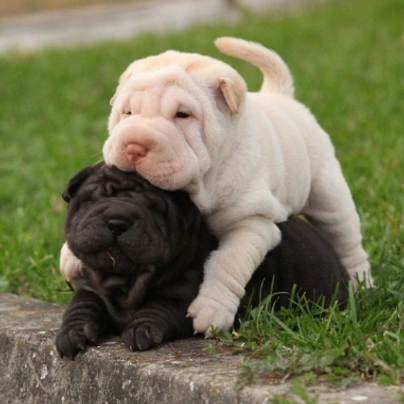Pets
Pets for studWanted petsBreedersAccessories & services
Knowledge hub
Support
Support & safety portalShar Pei
Pros
Cons
Introduction of the Shar Pei
The Shar Pei is one of the most recognised breeds in the world thanks to the wrinkles around their faces and their blue/black tongues. However a Shar Pei's coat too is another distinguishing feature of the breed because it is quite bristly to the touch although it looks like it should be soft. The Chinese Shar Pei boasts being one of the most ancient breeds on the planet and were originally bred to hunt guard and herd in their native China although they were often used as fighting dogs too.
The dogs we see today are less wrinkled and taller in the leg than the original dogs that first came out of China and back in the seventies they were considered one of the rarest breeds in the world. Thanks to careful and selective breeding the Shar Pei has become a popular choice with many people not only here in the UK but in other regions of the world and breeders have successfully bred out many of the health issues that once plagued the breed so much.
History of the Shar Pei
These extraordinary dogs have been around for centuries having first been developed by crossing Nordic dogs with Mastiff-type breeds. They boast a blue tongue which is one of the distinguishing physical traits of the Chow Chow and as such it is thought they too might well have been used to create the Shar Pei. The breed originated in China where they were originally bred to work as herding guarding and hunting dogs although at the time they were a popular choice as fighting dogs too.
Statuettes of dogs have been found in China that date back from 206 BC to 220 AD which was the time of the Han Dynasty and even today visitors to certain regions of the country will still see Shar Pei working alongside their owners whether hunting herding or guarding. Back in ancient times a Shar Pei's loose skin and short coarse coat offered them protection from their opponents when used as fighting dogs. They also have hooked canines which meant a Shar Pei could hold onto a dog they were fighting that much better. Their close small ears were harder for their opponents to grab hold of too.
At one time they were considered a delicacy in their native China which saw a law being passed forbidding anyone from owning a Shar Pei as a pet. It very nearly led to the breed vanishing off the face of the planet forever. However a breeder promoted the Shar Pei outside of China which luckily saved the breed from extinction although at that time these dogs were classed as one of the rarest breeds in the world.
The first dogs to be taken out of China were shorter in the leg and had a lot more folds and wrinkles with many adults suffering from a condition known as entropion a painful eye condition that needs veterinary attention. Over time with careful and selective breeding these issues have been successfully bred out of the Shar Pei with breeders producing dogs with longer legs not so many folds in their skin and much healthier eyelids.
It was during the last century when China's borders opened that fiercer breeds were introduced to the country which included the Bulldog and Mastiffs which were then mated to local dogs that the Shar Pei became less popular as a fighting breed in their native China. This saw the breed become more of a "home" dog that was kept for reasons other than fighting. This saw a rapid drop in breed numbers a dilemma that was not helped by the introduction of extremely high taxes for anyone who owned dogs on China's mainland.
During the late forties these taxes were increased and breeding was subsequently banned. As such by the fifties there were very few Shar Peis left in China with only a few being found on islands like Hong Kong and Macao. It was during the early seventies that a Hong Kong breeder called Matgo Law sent out a plea via magazines in the States asking for help to rescue the breed which led to the resurrection of the Shar Pei. In 1978 the breed suddenly caught the attention of the world and was registered in the Guinness Book of Records as being one of the rarest breeds on the planet.
Fortunately and through the concerted efforts of American breeders the Shar Pei was saved from extinction with the first dog arriving on British shores in 1981 with female Shar Peis following close behind a year later and they came directly from the Hong Kong breeder Matgo Law. Around 4 years later breed numbers had risen to about 350 dogs which were all registered with the Kennel Club. Their numbers steadily rose over the following years with Shar Peis being exported to other countries which included New Zealand Australia South Africa Italy Russia and Cyprus to name but a few.
The Kennel Club granted the Shar Pei Championship Status in 1999 and today the Shar Pei is one of the most popular breed in the UK and remains a popular pet in other countries too thanks to their extraordinary looks and kind loyal natures whether they are companions or family pets providing they live with people who are familiar with the breed or this type of dog.
Interesting facts about the breed
- Is the Shar Pei a vulnerable breed? No they are among the most popular dogs in the UK and elsewhere in the world thanks to their adorable looks and kind loving natures.
- A breeder in Hong Kong saved the breed from extinction and his name was Matgo Law
- The Shar Pei is one of the most expensive dogs in the world
- Their tongues can be black/blue or lavender in colour depending on a dog’s coat colour
- Some people believe that the Shar Pei is not an ancient breed at all but one that was developed in Hong Kong in the sixties by crossing Boxers with Bulldogs and Bloodhounds as well as Chinese Fighting Dogs
Appearance of the Shar Pei
Height at the withers: Males 46 - 56 cm Females 46 - 56 cm
Average weight: Males 25 - 29 kg Females 18 - 25 kg
The Shar Pei is one of the most recognisable dogs all thanks to the loose folds found on their faces and bodies. They are quite compact and square but very powerful looking showing a lot of bone. Their heads are quite large but not so much as it is disproportionate from the rest of their body. They have flat broad skulls with a moderate stop with dogs having a moderate amount of wrinkles on their cheeks and forehead.
They boast moderately broad slightly padded muzzles and lips. In profile their bottom jaw seems to be wider below than at the top. Their nose is wide large and ideally black in colour although other colours are allowed under the breed standard. Their eyes are almond-shaped medium in size dark in colour with dogs having their trademark frowning expression. Dogs with lighter coats can have lighter coloured eyes which is allowed. Ears are set high and are small thick and triangular shaped with slightly rounded tips they fold downwards towards a dog’s eyes.
Their tongue the roof of their mouth gums and flews are a bluish/black colour although dogs with lighter coats and amber eyes can have a self-coloured pigment in them and a lavender tongue. They have a strong jaw with a perfect scissor bite where their upper teeth neatly overlap their lower ones.
Necks are moderately long full and strong sitting well on a dog's shoulders with a little loose skin underneath being allowed. Shoulders are well laid back sloping and muscular. Front legs are straight and moderately long with dogs showing a good amount of bone but mature dogs do not have any wrinkles on their legs.
The Shar Pei has a compact sturdy body with a broad deep chest and short strong back. Their topline dips a little just behind the withers before rising to a dog's short but broad loin. In adults there is a little amount of wrinkling on their shoulders and at the base of their tail. Hindquarters are strong moderately angulated and muscular with dogs boasting powerful back legs. Feet are moderately large but compact with well knuckled toes. Their tails are nicely rounded and taper to a fine point with the base being set very high. Dogs carry their tail curved and high whether in a tight curl or curved over their backs.
When it comes to their coat the Shar Pei boasts having a very harsh straight coat that stands off the body but which is flatter on all four limbs. Their coats may look soft but in actual fact it is short and bristly to the touch and should never be trimmed. They do not have an undercoat and the length of the hair can vary from being short to thicker and longer but it always stands off a dog's body and is always coarse to the touch. All solid colours are acceptable with the exception of white and a dog's coat can be lighter on their tails the back of their thighs. They can be found in various colours which includes the following:
- Apricot
- Apricot Dilute
- Black
- Blue
- Brown
- Chocolate
- Chocolate Dilute
- Cream
- Cream Dilute
- Fawn
- Fawn Dilute
- Isabella
- Lilac
- Red
- Red Dilute
- Red Fawn
- Sable
Gait/movement
When a Shar Pei moves they do so freely and actively being well-balanced at all paces. At a fast trot a dog's back legs track singly which is normal for the breed and any Shar Pei that has a stilted gait is frowned upon by the Kennel Club.
Faults
The Kennel Club frowns on any exaggerations or departures from the Shar Pei's breed standard and the seriousness of any faults would be judged on how much they affect a dog's overall health and wellbeing as well as their ability to perform.
Males dogs must have both testicles fully descended into their scrotums and it is also worth noting that a Shar Pei can be a little bigger or smaller they can also be a little lighter or heavier than set out in the Kennel Club breed standard which is only to be used as a guide for the breed.
Temperament of the Shar Pei
The Shar Pei is a very loyal and affectionate dog by nature even though they may always have a frown on their faces. However they are not the best choice for first time owners because they need to be handled and trained by someone who is familiar with this type of dog. They are known to be quite independent and reserved but once they form a bond with their owners or families they become valued members of a household. These dogs love being inside the home where it is cosy and warm because they really dislike the cold.
They can be very wary and aloof when they meet anyone for the first time but would not show any sort of aggression towards a stranger preferring to just keep out of the way. It's essential for a puppy to be well socialised from a young age and their training has to start as soon as possible too. The Shar Pei needs to be taught who is the alpha dog in a household because they are much happier and more obedient when they know their place in the pack. If a Shar Pei is allowed to rule the roost they will and this can lead to a dog becoming unruly and hard to handle.
It is worth noting that Shar Peis tend to be very messy eaters thanks to their rather thick lips and jowls. The same can be said of when they drink any water which they do rather messily. With this said they are also known to like to keep themselves and their environment clean and providing their folds and creases are kept nice and clean Shar Peis rarely have that "doggy" smell about them.
Are they a good choice for first time owners?
The Shar Pei is not the best choice for first time dog owners because they need to be handled and trained by people who are familiar with the breed and their very specific needs bearing in mind that they can be quite hard to train because the Shar Pei is quite stubborn and wilful when the mood takes them.
What about prey drive?
The Shar Pei is known to have a high prey drive and therefore they are not to be trusted around smaller animals and pets. As such it's important to keep a Shar Pei on a lead when they are being walked in areas where other animals are known to roam and this includes wild animals and livestock.
What about playfulness?
Shar Peis although aloof and proud are also playful by nature with their families and enjoy playing interactive games. It is important to know when a Shar Pei is being playful and when they are showing a more dominant side to their natures which is why they are better suited to people who understand the nature of the breed.
What about adaptability?
Shar Peis need enough space to express themselves and as such they are better suited to households with large back gardens where a dog can roam around whenever they can. With this said the fencing must be ultra-secure to keep a Shar Pei safely in.
What about excessive barking?
Shar Peis are not known to be "barkers" and will generally only let their owners know when there are strangers about.
Do Shar Peis like water?
Some Shar Peis take to water like ducks whereas others don't even like to get their feet wet. Anyone who shares a home with a dog that does not like swimming should never force them into the water as this would just scare them even more. Owners with Shar Peis that enjoy swimming must take care when walking their dogs anywhere near more dangerous watercourses just in case their pets decide to leap in.
Are Shar Peis good watchdogs?
Shar Peis are always quick to let an owner know when they don't like something that is going on in their environment and because they are wary of strangers they would always react to when people they don't know are around.
Intelligence / Trainability of the Shar Pei
The Shar Pei is an intelligent dog but they need to be handled and trained with a firm yet fair hand. They do not respond well to any sort of harsh training or correction. However if an owner is too soft a Shar Pei as previously mentioned will start to show a more dominant side to their personality which is something to be avoided at all costs.
They do have a strong stubborn streak in them which means they need to be handled and trained by someone who is familiar with this type of dog. It takes a lot of patience and consistency to train a Shar Pei and even then they are not known to be the most obedient of dogs. This is why they are not the best choice for novice dog owners because a Shar Pei might get the better of them and start to show a more dominant side to their characters making them harder to handle and live with.
first commands a Shar Pei puppy should be taught are as follows:
- Come
- Sit
- Stay
- Quiet
- Leave it
- Down
- Bed
Children and other
The Shar Pei is a good choice as a family pet providing they have been well socialised from a young age and if they have they become devoted to every member of a household including the children. However care should be taken when they are around younger children and toddlers just in case playtime gets too rough and someone gets knocked over and hurt.
If a Shar Pei has grown up with a cat in the household they generally get on well with them. However they will think nothing of chasing a cat they do not know and if they catch them it would end in disaster. When it comes to smaller pets care should be taken when they are around a Shar Pei and any contact is best avoided. They can be aggressive towards other dogs especially if they have never met them before even when they have been well socialised so care should always be taken when a Shar Pei is being walked in a dog park or other areas where dogs are regularly exercised.
Health of the Shar Pei
The average life expectancy of a Shar Pei is between 9 and 15 years when properly cared for and fed an appropriate good quality diet to suit their ages.
Like so many other breeds the Shar Pei is known to suffer from a few hereditary health issues which are worth knowing about if you are planning share your home with one of these active and unique looking dogs. The conditions that seem to affect the breed the most include the following:
- Familial Shar Pei Fever (FSF)
- Amyloidosis
- Primary Lens Luxation (PLL) - test available
- Entropion
- SPAID
- Excessive wrinkling
- Bowed legs
- Joint luxations
- Hip dysplasia
- Kidney disease
- IgA deficiency
- Hypothyroidism
- Ear issues
- Swollen hock syndrome
What about vaccinations?
Shar Pei puppies would have had their first vaccinations but it's essential for them to have their follow-up jabs at the right time with the vaccination schedule being as follows:
- 10 -12 weeks old bearing in mind that a puppy would not have full protection straight away but would be fully protected 2 weeks after they have had their second vaccination
There has been a lot of discussion about the need for dogs to have boosters. As such it's best to talk to a vet before making a final decision on whether a Shar Pei should continue to have annual vaccinations which are known as boosters.
What about spaying and neutering?
A male Shar Pei can safely be neutered when they are 6 months old and females can be spayed when they are 6 months old too.
What about obesity problems?
It's important to feed Shar Peis a correct diet and to give them the right amount of daily exercise to prevent dogs from gaining too much weight. Some Shar Peis put on weight once they have been spayed or neutered and again it's important to adjust a dog's calorie intake if they do and to discuss things with the vet. Obesity can negatively impact a Shar Pei's health and wellbeing shortening their lives by several years.
What about allergies?
Because the Shar Pei has so many folds and wrinkles on their faces and bodies they are prone to suffering from skin issues if the folds are not kept immaculately clean. Some dogs develop allergies which can prove hard to clear up and finding the triggers is challenging. The most common triggers for allergies flaring up include the following:
- Environment
- A reaction to certain chemicals commonly found in household cleaning products
- Seasonal allergies which includes pollen and grasses
- Food which includes certain meats and cereals often used as ingredients in commercially produced dog food
- Tick and flea bites
- Dust mites
- Mould
Participating in health schemes
The Kennel Club strongly recommends that all Assured Breeders and other breeders use the following scheme which available for the Shar Pei:
- DNA test - POAG/PLL
All Shar Pei females should not be bred from under the age of 2 years and any puppies from a litter would not be accepted for registration by the Kennel Club.
What about breed specific breeding restrictions?
Currently there are no breed specific breeding restrictions for the Shar Pei but all potential owners should ask breeders about any health issues that are known to affect the breed.
What about Assured Breeder requirements?
All Assured Breeders should have stud dogs tested using the following scheme and no bitch under the age of 2 years should produce a litter.
- DNA test - POAG/PLL
Caring for the Shar Pei
As with any other breed the Shar Pei needs to be groomed on a regular basis to make sure their coats and skin are kept in top condition. They also need to be given regular daily exercise to ensure they remain fit and healthy. On top of this dogs need to be fed good quality food that meets all their nutritional needs throughout their lives to ensure they remain fit and healthy.
Caring for a Shar Pei puppy
Shar Pei puppies are incredibly cute and it is all too easy to spoil them but the first few weeks after their arrival are important because it's the time to set ground rules boundaries and limits so a puppy understands what is expected of them. Setting things up for their arrival means puppy-proofing not only the home but the garden too. All puppies like to gnaw on things and this includes electric wires and cables which is why it's important for them to be put well out of a puppy's reach.
When it comes to the garden storing away any tools and other implements makes sure a puppy would not injure themselves on them. but it's also essential to check that the fencing is secure and that there are no toxic plants growing in flower beds which could end up making a puppy very ill.
Puppies sleep for up to 21 hours a day so it's important to set up a quiet area for them to nap in. The area should not be too out of the way because a puppy needs to know someone is around and that they are not all alone in a strange environment away from their mothers and their litter mates. The ideal place is somewhere they can be watched over and heard but where they would not be disturbed by too much traffic walking by.
A Shar Pei puppy would have been wormed before being sold and the documentation a breeder provides for a puppy must have all the details of their worming date and the product used as well as the information relating to their microchip. It is essential for puppies to be wormed again keeping to a schedule which is as follows:
- Puppies should be wormed at 6 months old
- They need to be wormed again when they are 8 months old
- Puppies should be wormed when they are 10 months old
- They need to be wormed when they are 12 months old
Things you'll need for your puppy
There are items needed to care for a puppy which should be purchased well in advance of their arrival and this includes the following:
- Feed and water bowls making sure they are not too deep and ideally they should be ceramic rather than plastic or metal
- A good quality dog collar harness and lead
- A dog crate that's not too small or too big that a puppy would feel lost in it
- A well-made dog bed bearing in mind that a puppy could well chew on it
- Baby and/or dog blankets to use in the puppy's crate and dog bed
- Dog specific toothpaste and tooth brush
- Shampoo and conditioner specifically formulated for use on dogs
- Grooming equipment
Keeping the noise down
All puppies are very sensitive to loud noises so it is important to keep the volume of a television down and not to play music too loudly either because it could frighten a Shar Pei puppy and prevent them from napping as they should during the day.
Keeping vet appointments
Puppies are always vaccinated before they are sold but as previously mentioned it is up to their new owners to make sure they are given their follow-up shots at the right time which should be as follows:
- 10 -12 weeks old bearing in mind that a puppy would not have full protection straight away but would only be fully protected 2 weeks after they have had their second vaccination
When it comes to boosters it's best to discuss these with a vet because there is a lot of debate about whether a dog really needs them after a certain time. However if a dog ever needed to go into kennels their vaccinations would need to be
What about Shar Peis when they reach their golden years?
When Shar Peis reach their golden years they do slow down in many ways and they might start showing their age with more grey hairs appearing on their faces and more especially around their muzzles. Apart from a change in their appearance a Shar Pei's personality might change too and this includes on how quick they are to respond to a command or when their names are called. The reason for this is that many older dog's hearing is not as good as it once was. Other changes to watch out for in a Shar Pei when they reach their senior years include the following:
- Their vision might be impaired and their eyes seem cloudy
- Their teeth might not be as in good condition which means they may need dental work
- Older dogs tend to sleep more during the day and they get up more frequently at night which is often because their cognitive function is not as sharp as it was when they were young which means older dogs are more easily confused
- They tend to be less tolerant of loud noises and sounds
- Older dogs often suffer from arthritis so it's important to invest in a comfy dog bed and ideally one that a Shar Pei finds easier to get out of
- Dogs when they are older can be a little fussier about their food so it's important to rethink their diet and to make sure they are getting all the nutrients they need to stay healthy
- An older dog's immune system often does not offer them the same protection against illness and infection which puts them more at risk of catching something and why they should see the vet more routinely
- An older Shar Peis might not be so keen to go out for a walk and more especially longer ones
- They muscle tone and body condition is not as good as when they were young
Grooming of the Shar Pei
Thanks to their coats being short and because they no or very little undercoat the Shar Pei is not high maintenance in the grooming department. However it's essential for their folds and wrinkles to be checked on a regular basis to make sure they are kept clean and to always dry them thoroughly because if moisture builds up in the wrinkles it provides the perfect environment for a yeast infection to take hold which can be very hard to clear up.
It's also very important to check a Shar Pei's ears as often as possible and to clean them when necessary. If too much wax builds up in a dog's ear it can lead to an infection taking hold which once it flares up can lead to all sorts of other ear issues if not treated correctly. It's also important to check a dog's eyes and to clean them when necessary.
Grooming tools needed for a Shar Pei
Having the right grooming tools helps keep a Shar Pei's coat and skin in top condition. The tools needed to keep a dog's coat looking good are as follows:
- A grooming glove
- A slicker brush
- A bristle brush
- A fine toothed comb
- Nail clippers
- A pair of round ended scissors
- Dog specific shampoo and conditioner
- Lots of baby wipes to clean a dog's wrinkles and folds
Exercise of the Shar Pei
The Shar Pei is not a high energy dog but they do need to be given the right amount of daily exercise and enough mental stimulation to prevent boredom from setting in. With this said two walks a day with the first morning walk being shorter and the second in the afternoon being longer and more interesting is essential to keep these dogs happy healthy and fit.
They really enjoy letting off steam in a back garden whenever possible but the fencing has to be very secure to keep a Shar Pei in. If they are not given enough exercise or enough mental stimulation it can lead to dogs developing unwanted behavioural issues which includes them being destructive around the home.
With this said young Shar Pei puppies should not be given too much exercise because their joints and bones are still growing and too much pressure on them could result in causing a dog a few problems later in their lives. They should not be allowed to run up and down stairs or to jump up and down off the furniture because it puts too much strain on their growing joints.
Feeding of the Shar Pei
If you get a Shar Pei puppy from a breeder they would give you a feeding schedule and it's important to stick to the same routine feeding the same puppy food to avoid any tummy upsets. You can change a puppy's diet but this needs to be done very gradually always making sure they don't develop any digestive upsets and if they do it's best to put them back on their original diet and to discuss things with the vet before attempting to change it again.
Older dogs are not known to be fussy or finicky eaters but this does not mean you can feed them a lower quality diet. It's best to feed a mature dog twice a day once in the morning and then again in the evening making sure it's good quality food that meets all their nutritional requirements. It's also important that dogs be given the right amount of exercise so they burn off any excess calories or they might gain too much weight which can lead to all sorts of health issues. Obesity can shorten a dog's life by several years so it's important to keep an eye on their waistline from the word go.
Feeding guide for a Shar Pei puppy
Once a puppy is settled into their new homes it is safe to change their diets but as previously touched upon it needs to be done gradually and carefully to avoid any tummy upsets. As a rough guide Shar Pei puppies can be fed the following amounts every day to ensure they are getting all the nutrients they need to grow and develop properly:
- 2 months old - 153 g to 238 g depending on a puppy's build
- 3 months old - 179 g to 292 g depending on a puppy's build
- 4 months old - 191 g to 318 g depending on a puppy's build
- 5 months old - 194 g to 339 g depending on a puppy's build
- 6 months old - 194 g to 361 g depending on a puppy's build
- 8 months old - 157 g to 325 g depending on a puppy's build
- 10 months old - 139 g to 261 g depending on a puppy's build
Once a puppy is 11 months old they can be fed adult dog food as shown below.
Feeding guide for a Shar Pei
As a rough guide an adult fully grown Shar Pei can be fed the following amounts every day to ensure they stay fit and healthy:
Average weight: Males 25 - 29 kg Females 18 - 25 kg
- Dogs weighing 18 kg can be fed 215 g to 283 g depending on activity
- Dogs weighing 25 kg can be fed 275 g to 362 g depending on activity
- Dogs weighing 29 kg can be fed 305 g to 365 g depending on activity
Shar Pei price
If you are looking to buy a Shar Pei you would need to pay anything from £750 to over £1100 for a well-bred pedigree puppy. Finding insurance cover for a Shar Pei can be quite hard but some companies will agree to offer cover to the breed. The cost of insuring a male 3-year-old Shar Pei in northern England would be £61.43 a month for basic cover but for a lifetime policy this would set you back £137.13 a month (quote as of August 2017). When insurance companies calculate a pet's premium they factor in several things which includes where you live in the UK and a dog's age and whether they have been neutered or spayed.
When it comes to food costs you need to buy the best quality food whether wet or dry to feed your dog throughout their lives making sure it suits the different stages of their lives. This would set you back between £50 - £70 a month. On top of this you would need to factor in veterinary costs if you want to share your home with a Shar Pei and this includes their initial vaccinations their annual boosters the cost of neutering or spaying your dog when the time is right and their yearly health checks all of which quickly adds up to over a £1200 a year.
As a rough guide the average cost to keep and care for a Shar Pei would be between £80 to £120 a month depending on the level of insurance cover you opt to buy for your dog but this does not include the initial cost of buying a well-bred pedigree Shar Pei puppy.
Buying advice
When visiting and buying any puppy or dog there are many important things to consider and questions to ask of the breeder/seller. You can read our generic puppy/dog advice here which includes making sure you see the puppy with its mother and to verify that the dog has been wormed and microchipped.
The Shar Pei is an extremely popular breed both in the UK and elsewhere in the world which means that well-bred puppies command a lot of money. As such with the Shar Pei there is specific advice questions and protocols to follow when buying a puppy which are as follows:
- Beware of online scams and how to avoid them. You may see online and other adverts by scammers showing images of beautiful Shar Pei puppies for sale at very low prices. However the sellers ask buyers for money up front before agreeing to deliver a puppy to a new home. Potential buyers should never buy a puppy unseen and should never pay a deposit or any other money online to a seller. You should always visit the pet at the sellers home to confirm they are genuine and make a note of their address.
- As previously touched upon the Shar Pei is among the most popular breeds in the UK. As such there are many amateur breeders/people who breed from a Shar Pei far too often so they can make a quick profit without caring for the welfare of the puppies their dam or the breed in general. Under Kennel Club rules a dam can only produce 4 litters and she must be between a certain age to do so. Anyone wishing to buy a Shar Pei puppy should think very carefully about who they purchase their puppy from and should always ask to see the relevant paperwork pertaining to a puppy's lineage their vaccinations and their microchipping.
- It is also crucial that a Shar Pei bitch has not produced any litters before the age of 2 years old and all potential owners should always verify the age of a puppy's mother before completing their purchase.
Related adverts
See all
2 beautiful shar- peis for sale
£450
Flower girl sharpei
£695

K c registered Brown Shar Pei puppy for sale
£1,000
